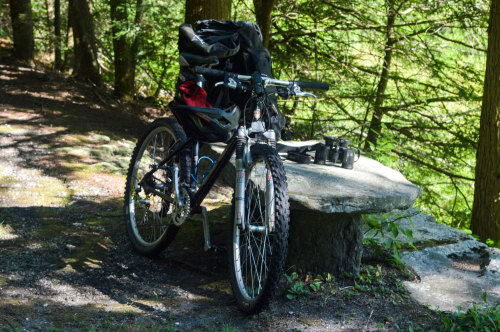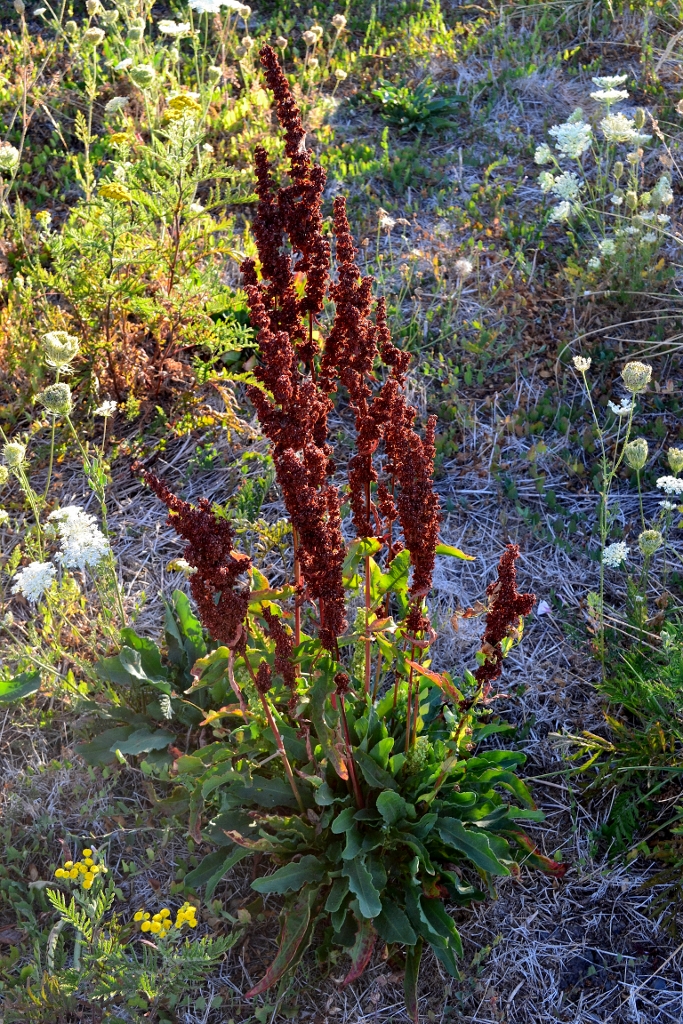#wild edibles
The Tait Section of the Billings Trail in Norfolk Connecticut
This was a nice little bike ride about a mile and a half one way with almost no intense inclines. I usually push myself with tough trails, but this time I took it easy. The only time I couldn’t ride the trail was a little patch of mud and a few hundred feet at the very end. Right before it connects to Winchester Road it turns into a small path that has to be walked.
A little more than halfway through the Tait section of the Billings Trail, right where the trail intersects with the Mad River there’s a little rest area with a stone bench that has the words MAD RIVER deeply engraved on the top of the stone seat. I thought it was a nice touch even though the Mad River is more of a brook at this stage.
All of the red flowers you see in he pictures are the Cardinal Flower ( Lobelia Cardinalis). I’ve seen this flower out in the wild before, but never in these numbers. The brilliant deep red color is really a sight. I can’t think of another wild flower that stands out nearly as much as the Cardinal flower. More often than not I’ll add colors in Photoshop to make the reds redder and the greens greener, but this close up picture of the Cardinal Flower is totally natural.
Medicinal useofCardinal Flower:
Emetic (induces vomiting), expectorant (helps bring up mucus and other material from the lungs, bronchi, and trachea) and a nervine (calms the nerves). The root is analgesic (a pain reliever), anthelmintic (expels parasites from the body), antispasmodic and stomachic (promotes appetite and aids digestion) . A tea made from the roots has been used in the treatment of epilepsy, syphilis, typhoid, stomach aches, cramps, worms etc. Several Native American tribes used the leaves as a substitute for tobacco. I have also read other accounts that claim some Native American tribes actually used it in a blend with tobacco and some other herbs like Mullein. This makes more sense to me because I have smoked the leaves and though it is a pleasant smoke it’s fairly thin. It lacks the full bodied flavor of tobacco or marijuana etc.
Another interesting plant growing there is the Broadleaf Arrowhead plant(Sagittaria latifolia). It’s called the Broadleaf Arrowhead plant because the leaves look like a giant arrowhead. The leaves are about 12 inches long and about 6 inches wide. It’s also known by other names such as Duck Potato, Indian potato, or Wapato. So you may have figured out that the roots develop tubers which are like potatoes. A potato is a tuber. You can cook the Duck Potato all of the same ways that you cook a regular potato. They say that the taste is similar to a chestnut. It’s hard to make out, but they are in the second to the last picture at the edge of the bog. From the trail I could see the giant leaves, but I needed the binoculars to see the white and yellow flowers of this plant.
All Photographs by Gary Cremese.
Post link
Sorry about the radio silence folks, I’ve been crazy busy and haven’t had a spare moment to update my web presence! Have some little spot illustrations of mushrooms to make up for it. All edible and all found in north america- it’s an informal guess-the-species game, since I uploaded the version without captions.
Post link
A Christmas miracle


Flour, salt, pepper, nutritional yeast, butter, olive oil. (Yup nutritional yeast.)


Pleurotus ostreatus. 12.25.21
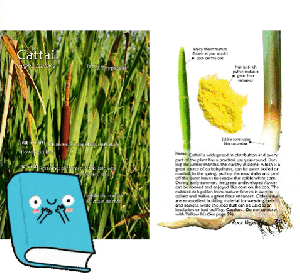
Hi Folks,
I am very excited to announce the launch of our Kickstarter campaign starting Saturday, May 23, 2020! The goal of this campaign is to raise the funds needed to print another batch of my book: The Northwest Forager’s Pocket Guide to Wild Edible Plants. This is an exciting opportunity for everyone who makes a pledge.
- $1 gets your name credited in this print.
- $15 gets you your own personal…
Prevent Weeds with a Weed: Lambsquarters by Suburban Homestead
“Here’s a crazy idea: why not use a weed to prevent other weeds in the garden. Lambsquarters is an edible weed that is perfect for that.
Survival Food: Japanese Knotweed Shoots by Animal Man Survivor
“This plant is one of the most important wild foods to know- partly because of the huge volume of food you can get quickly, and also because of this plant’s extensive range.” -Animal Man Survivor. For more great videos by Animal Man Survivor please check out his>> youtube channel.
Survival Medicine – Hawthorn (Crataegus) by Survival Lilly
“In this video I… talk about the positive effects that Hawthorn leaves and bloom have on the human heart.
Harvesting and cooking Morel Mushrooms by GuideYouOutdoors
“While cleaning up trash around my campsite in the morning I stumbled across a spore trail of morel mushrooms.” -GuideYouOutdoors…
Roasting Wild Carrot on a Camp Fire by The Northwest Forager
In this episode of The Northwest Forager we learn one method on how to prepare and roast wild carrot on a campfire using nothing more than the natural elements around. For more videos from the Northwest Forager please subscribe>> here.
Wild Field Mustard: How to Pick & Process by Haphazard Homestead
“This video shows how to identify and pick Wild Field Mustard that’s growing as a weed in your garden, or out in the wild.
Survival Medicine: Birch Leaves by Survival Lilly
Survival Medicine - Birch Leaves (Betula) For more great videos by Survival Lilly be sure to visit her >> youtube channel.
How to video: Wild lemonade style tea
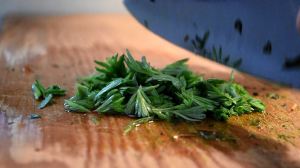
In this episode we will make a delicious and refreshing lemonade style beverage using Wood Sorrel (Oxalis oregana) and fresh Western Hemlock (Tsuga heterophylla) sprouts.
Recipe:
1/3 cup chopped wood sorrel leaves & stems
¼ cup chopped hemlock sprouts
¼ sugar or honey
1 pint of cold waterFinely chop both the wood sorrel and…
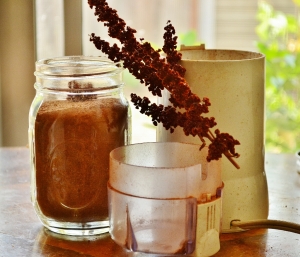
Dock (Rumex) consist of a variety of edible plants found over most of the Earth. Two of the most commonly known varieties is Curly Dock and the Broad-leaved Dock. Typically it’s the vitamin-rich leaves which are most often enjoyed. In today’s article, however, we will consider the use of Dock’s seeds.
Curly Dock – Rumex crispus
Dock is both protrusive and wide-spread in its distribution. Therefor…
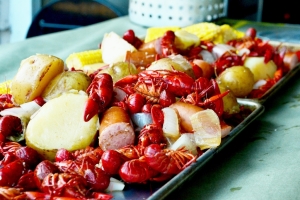
Arthropods and Crustaceansaka Water Bugs! In the western civilization that’s typically not our idea of a lip smacking entrée. However, add some Cajun sauce, sliced potatoes, corn and sausage, boiled with 5lbs of Crawfish, and that’s just what you get. A lip smacking, shell cracking, disemboweling, finger licking water bug dinner. Sound disgusting or maybe even barbaric? Try both. Even so that…
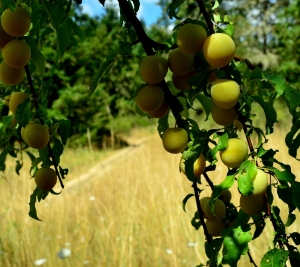
When harvest is abundant, Fruit liquors are a fun and tasty way to enjoy the extra fruit hanging around. In this article we’ll go over 5 easy steps in preparing fruit liquor with the fruit of your choice.
IngredientsStep 1 – Choosing the fruit
- Fresh Fruit
- Sugar
- Vodka or Tequila
Pick a fruit that is fully ripe, full of juice, and can easily be packed into a jar without crushing. In this case,…
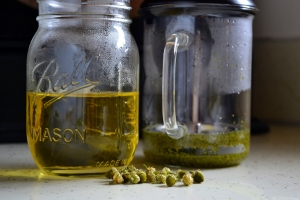
For this months pick I am pleased to share a couple videos from some of my favorite youtuber’s. Each one may have their own flare, but all of them teach with the concept of developing symbiosis with the natural world. If you like what you see below then you may consider checking out their own personal youtube channels.
First is a series by a man named Eric who’s channel is called GardenFork. He…
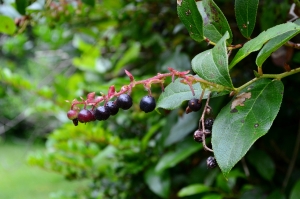
Gaultheria shallonA Salal shrub (Gaultheria shallon) well established on a piece of drift wood as commonly seen along the Oregon coast.
Salal berry could be perhaps one of the most widely abundant and under appreciated wild fruits of the Pacific Northwest. Common along coast lines, coniferous forest, logging roads, and river banks, Salal is a delightful treat that can be enjoyed during most…
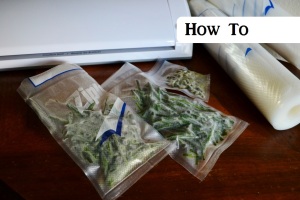
We wait all year for our favorite delicacy to come into season only to watch it spring, mature and wither before our very eyes. Living in the high speed world of today we’re fortunate just to get a taste or two while it’s still in its prime. So unless one is a fulltime “hunter and gatherer”… initiating methods of food preservation is a must if we are to capture the seasonally fresh flavor of…
She has a FREEEEE online event coming up at the US Botanical Garden -

